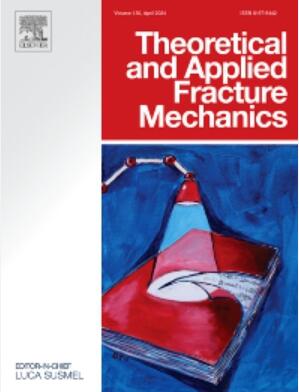采用 MMTS 标准确定试样尺寸对沥青混合料混合模式 I 和混合模式 II 断裂行为的影响
IF 5
2区 工程技术
Q1 ENGINEERING, MECHANICAL
引用次数: 0
摘要
本研究探讨了试样直径对沥青混合料开裂行为的影响。在不同的断裂模式和温度下,对直径分别为 64、86 和 150 毫米的 SCB 试样进行了测试。确定了测试试样的断裂韧性和断裂能这些重要的断裂参数。研究结果表明,Me(模式混合度)值的增加导致断裂韧性降低,但断裂能增加。考虑到所有试样尺寸和测试温度,混合模式 I/II 和纯模式 II 的断裂韧性平均分别比纯模式 I 加载时低 13% 和 29%。相反,混合模式 I/II 和纯模式 II 的断裂能分别比纯模式 I 加载时平均高出 19% 和 38%。较大的试样在断裂韧性和断裂能方面都有所提高。考虑到所有加载模式和测试温度,直径为 86 毫米和 150 毫米的试样的断裂韧性分别比直径为 64 毫米的试样平均高出 9% 和 26%。相应的断裂能也分别提高了 8% 和 14%。此外,还观察到断裂韧性随着温度的降低而增加,直到零下 20 °C,之后又有所下降。另一方面,在所有试样尺寸和混合模式下,断裂能随着试验温度的升高而增加,由于沥青混凝土的脆性,在 10 °C 时断裂能显著增加。此外,断裂带的大小(rc)受温度和试样尺寸(R)的影响,R 越大,rc 越大。然而,温度降低最初会导致 rc 稍微减小,随后会增大。研究得出结论,MMTS(修正的最大切向应力)准则能有效预测 SCB 试样在各种尺寸和加载模式下的断裂行为,为沥青混合料断裂行为提供准确的估计。考虑到所有加载模式和试验温度,试样直径为 64 毫米、86 毫米和 150 毫米时的平均误差值分别为 5.9%、6.2% 和 6.5%。本文章由计算机程序翻译,如有差异,请以英文原文为准。
Impact of specimen size on mixed mode I and II fracture behavior of asphalt mixture using MMTS criterion
This study investigates how the diameter of specimens impacts the cracking behavior of asphalt mixtures. Testing was conducted on SCB specimens with diameters of 64, 86, and 150 mm under different fracture modes and temperatures. Fracture toughness and fracture energy, crucial fracture parameters, were determined for the tested specimens. The findings revealed that an increase in Me (mode mixity) values led to a decrease in fracture toughness but an increase in fracture energy. By considering all specimen sizes and test temperatures, the fracture toughness for mixed mode I/II and pure mode II was, on average, 13 % and 29 % lower than that for pure mode I loading, respectively. Conversely, the fracture energy for mixed mode I/II and pure mode II was, on average, 19 % and 38 % higher than that for pure mode I loading, respectively. Larger specimens exhibited enhancements in both fracture toughness and fracture energy. Considering all loading modes and test temperatures, the fracture toughness for specimen diameters of 86 mm and 150 mm was, on average, 9 % and 26 % higher than that for a diameter of 64 mm, respectively. The corresponding improvements in fracture energy were 8 % and 14 %, respectively. Additionally, it was observed that fracture toughness increased with decreasing temperature until −20 °C, after which it declined. On the other hand, fracture energy rose with increasing test temperature for all specimen sizes and mode mixities, with a notable increase at 10 °C due to the brittle nature of asphalt concrete. Moreover, the size of the fracture zone (rc) was influenced by temperature and specimen size (R), with larger R resulting in an increase in rc. However, a decrease in temperature initially caused a slight decrease in rc followed by an increase. The study concluded that the MMTS (modified maximum tangential stress) criterion effectively predicted the fracture behavior of SCB specimens across various sizes and loading modes, providing accurate estimations for asphalt mixture fracture behavior. By considering all loading modes and test temperatures, the average error values were 5.9 %, 6.2 %, and 6.5 % for specimen diameters of 64 mm, 86 mm, and 150 mm, respectively.
求助全文
通过发布文献求助,成功后即可免费获取论文全文。
去求助
来源期刊

Theoretical and Applied Fracture Mechanics
工程技术-工程:机械
CiteScore
8.40
自引率
18.90%
发文量
435
审稿时长
37 days
期刊介绍:
Theoretical and Applied Fracture Mechanics'' aims & scopes have been re-designed to cover both the theoretical, applied, and numerical aspects associated with those cracking related phenomena taking place, at a micro-, meso-, and macroscopic level, in materials/components/structures of any kind.
The journal aims to cover the cracking/mechanical behaviour of materials/components/structures in those situations involving both time-independent and time-dependent system of external forces/moments (such as, for instance, quasi-static, impulsive, impact, blasting, creep, contact, and fatigue loading). Since, under the above circumstances, the mechanical behaviour of cracked materials/components/structures is also affected by the environmental conditions, the journal would consider also those theoretical/experimental research works investigating the effect of external variables such as, for instance, the effect of corrosive environments as well as of high/low-temperature.
 求助内容:
求助内容: 应助结果提醒方式:
应助结果提醒方式:


